LSBM105 Business and Corporate Law: Contract Law Analysis Essay
VerifiedAdded on 2022/08/12
|10
|2268
|18
Essay
AI Summary
This essay analyzes a business law scenario to determine the validity of a contract between two parties, James and Elizabeth. The essay meticulously examines the essential elements of a contract, including offer, acceptance, consideration, and the intention to create a legal relationship, referencing key legal precedents such as *Adam v Lindsell* and *Hyde v Wrench*. The application section dissects the specifics of the case, evaluating whether Elizabeth's actions constituted a valid acceptance or a counteroffer under postal rules. The analysis considers the timing of communications, especially Elizabeth's acceptance and counteroffer, in relation to the postal rule. The conclusion firmly establishes that a valid contract was formed, specifying the exact time and date of its creation based on the application of contract law principles.
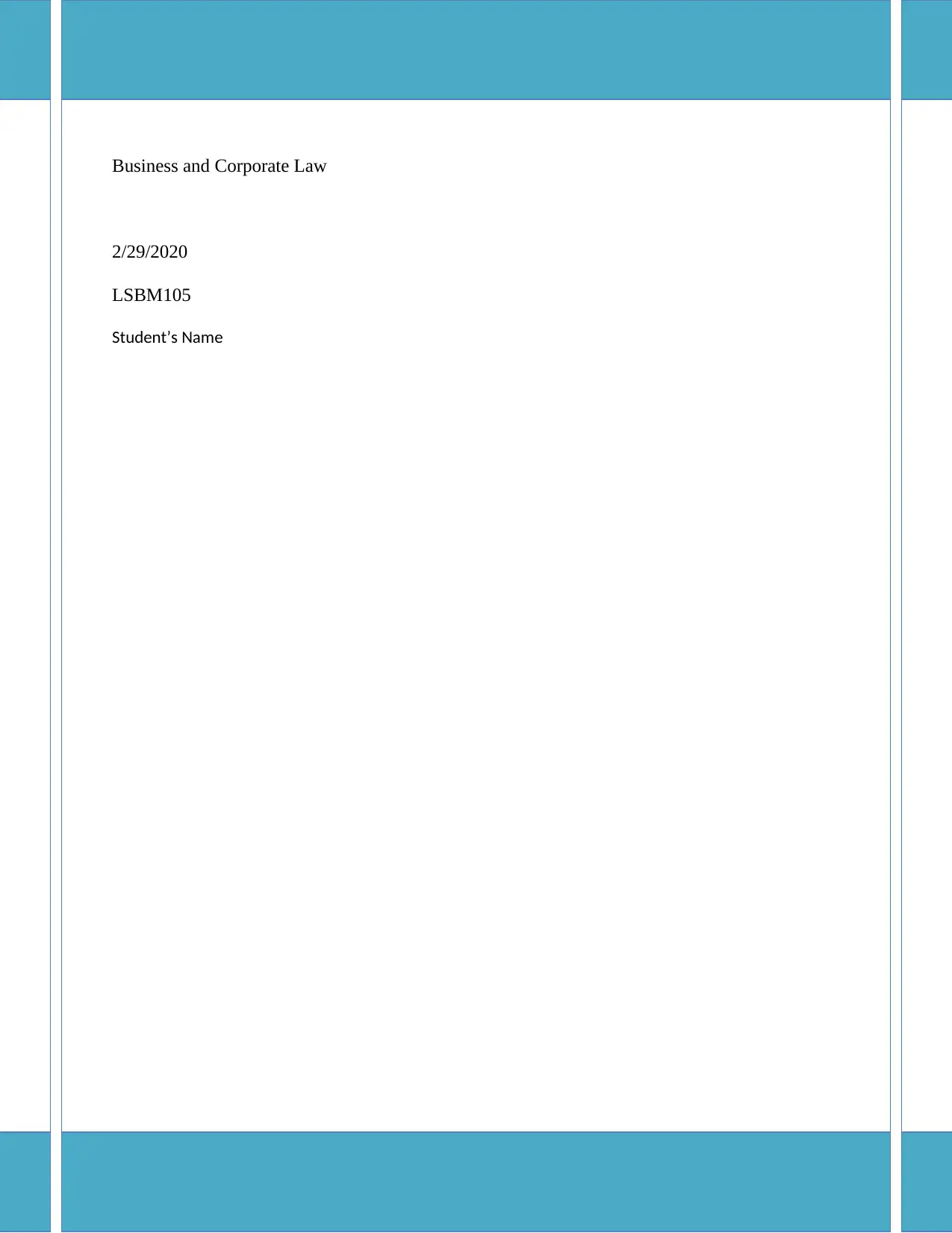
Running Head: BUSINESS AND CORPORATION LAW 0
Business and Corporate Law
2/29/2020
LSBM105
Student’s Name
Business and Corporate Law
2/29/2020
LSBM105
Student’s Name
Paraphrase This Document
Need a fresh take? Get an instant paraphrase of this document with our AI Paraphraser
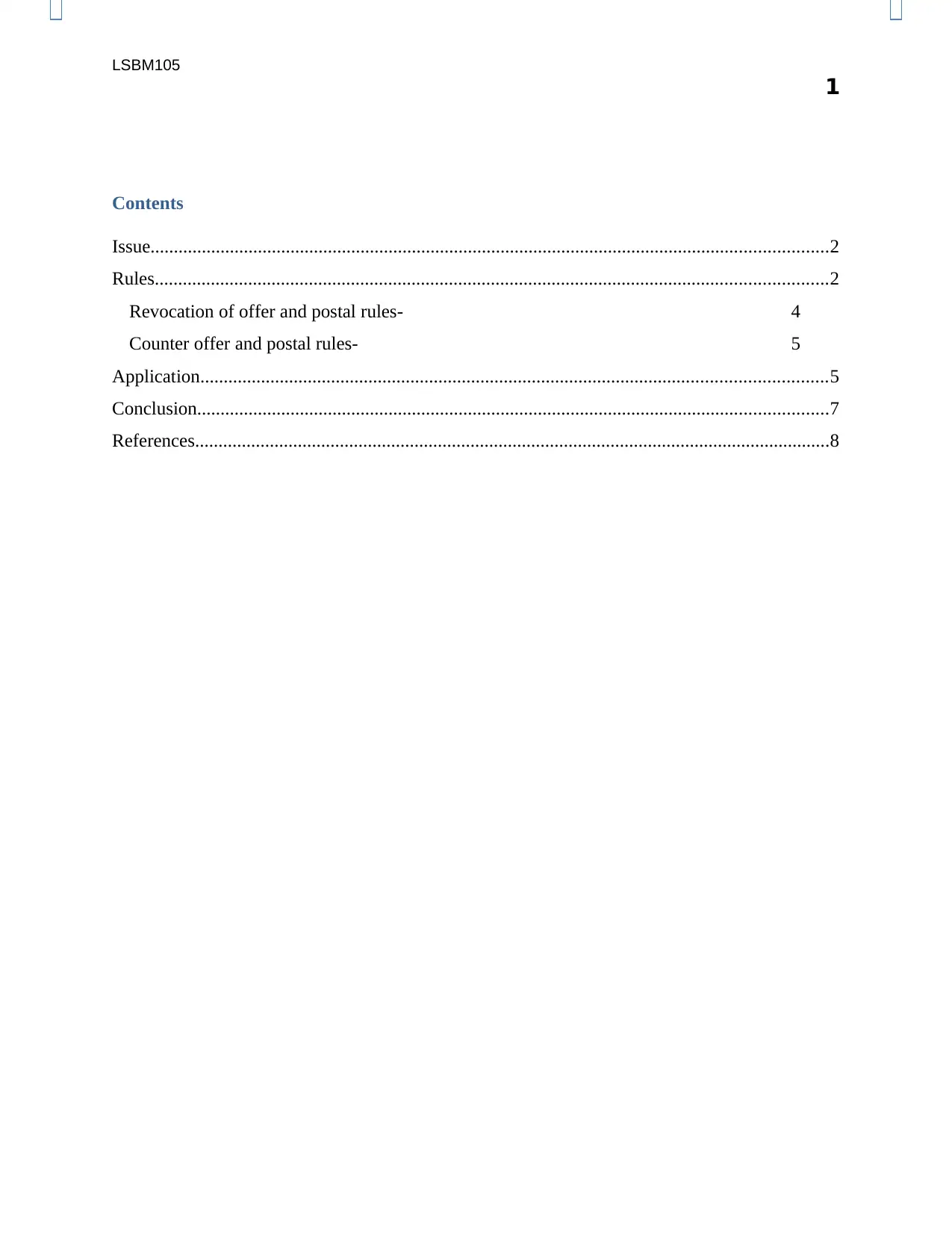
LSBM105
1
Contents
Issue.................................................................................................................................................2
Rules................................................................................................................................................2
Revocation of offer and postal rules- 4
Counter offer and postal rules- 5
Application......................................................................................................................................5
Conclusion.......................................................................................................................................7
References........................................................................................................................................8
1
Contents
Issue.................................................................................................................................................2
Rules................................................................................................................................................2
Revocation of offer and postal rules- 4
Counter offer and postal rules- 5
Application......................................................................................................................................5
Conclusion.......................................................................................................................................7
References........................................................................................................................................8
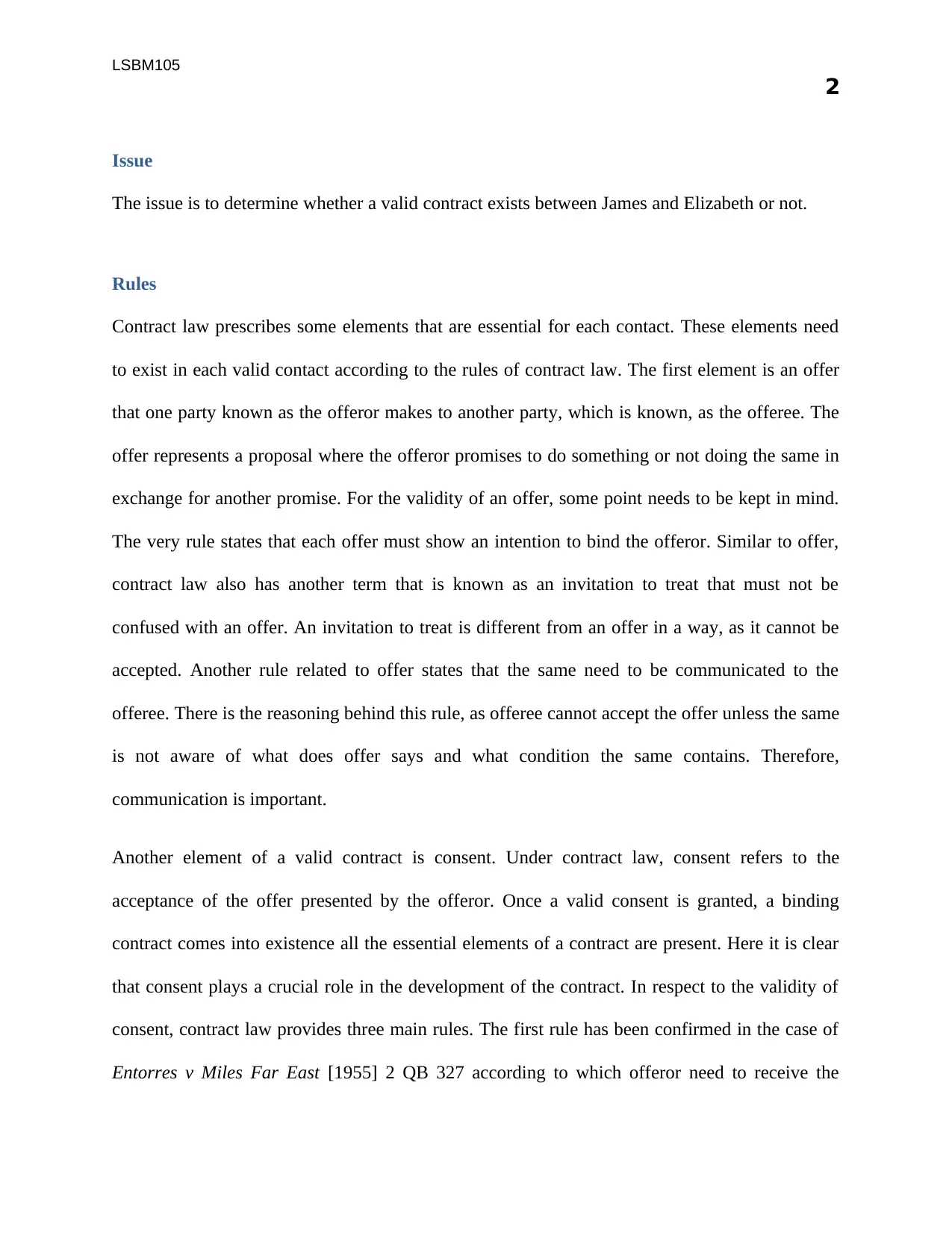
LSBM105
2
Issue
The issue is to determine whether a valid contract exists between James and Elizabeth or not.
Rules
Contract law prescribes some elements that are essential for each contact. These elements need
to exist in each valid contact according to the rules of contract law. The first element is an offer
that one party known as the offeror makes to another party, which is known, as the offeree. The
offer represents a proposal where the offeror promises to do something or not doing the same in
exchange for another promise. For the validity of an offer, some point needs to be kept in mind.
The very rule states that each offer must show an intention to bind the offeror. Similar to offer,
contract law also has another term that is known as an invitation to treat that must not be
confused with an offer. An invitation to treat is different from an offer in a way, as it cannot be
accepted. Another rule related to offer states that the same need to be communicated to the
offeree. There is the reasoning behind this rule, as offeree cannot accept the offer unless the same
is not aware of what does offer says and what condition the same contains. Therefore,
communication is important.
Another element of a valid contract is consent. Under contract law, consent refers to the
acceptance of the offer presented by the offeror. Once a valid consent is granted, a binding
contract comes into existence all the essential elements of a contract are present. Here it is clear
that consent plays a crucial role in the development of the contract. In respect to the validity of
consent, contract law provides three main rules. The first rule has been confirmed in the case of
Entorres v Miles Far East [1955] 2 QB 327 according to which offeror need to receive the
2
Issue
The issue is to determine whether a valid contract exists between James and Elizabeth or not.
Rules
Contract law prescribes some elements that are essential for each contact. These elements need
to exist in each valid contact according to the rules of contract law. The first element is an offer
that one party known as the offeror makes to another party, which is known, as the offeree. The
offer represents a proposal where the offeror promises to do something or not doing the same in
exchange for another promise. For the validity of an offer, some point needs to be kept in mind.
The very rule states that each offer must show an intention to bind the offeror. Similar to offer,
contract law also has another term that is known as an invitation to treat that must not be
confused with an offer. An invitation to treat is different from an offer in a way, as it cannot be
accepted. Another rule related to offer states that the same need to be communicated to the
offeree. There is the reasoning behind this rule, as offeree cannot accept the offer unless the same
is not aware of what does offer says and what condition the same contains. Therefore,
communication is important.
Another element of a valid contract is consent. Under contract law, consent refers to the
acceptance of the offer presented by the offeror. Once a valid consent is granted, a binding
contract comes into existence all the essential elements of a contract are present. Here it is clear
that consent plays a crucial role in the development of the contract. In respect to the validity of
consent, contract law provides three main rules. The first rule has been confirmed in the case of
Entorres v Miles Far East [1955] 2 QB 327 according to which offeror need to receive the
⊘ This is a preview!⊘
Do you want full access?
Subscribe today to unlock all pages.

Trusted by 1+ million students worldwide
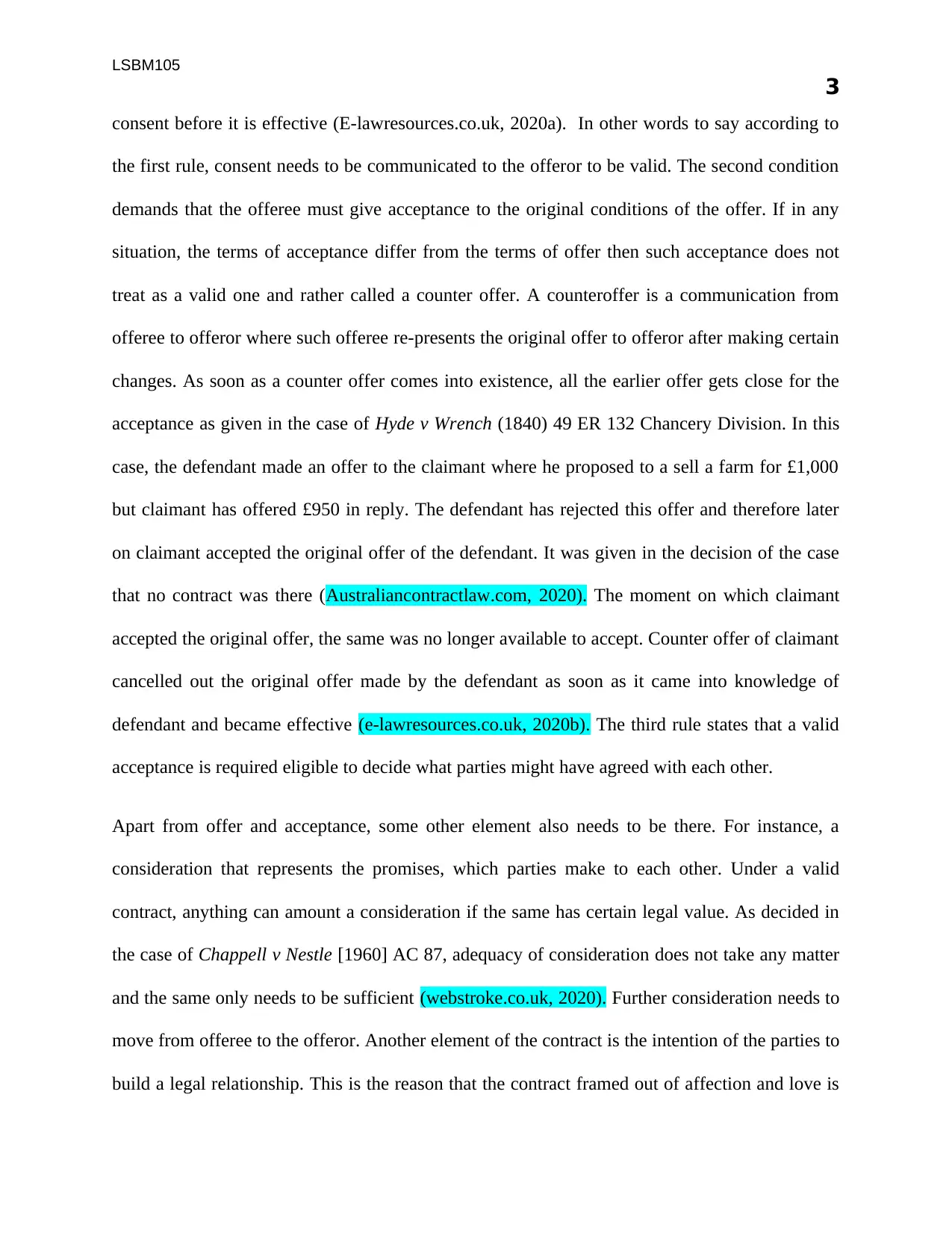
LSBM105
3
consent before it is effective (E-lawresources.co.uk, 2020a). In other words to say according to
the first rule, consent needs to be communicated to the offeror to be valid. The second condition
demands that the offeree must give acceptance to the original conditions of the offer. If in any
situation, the terms of acceptance differ from the terms of offer then such acceptance does not
treat as a valid one and rather called a counter offer. A counteroffer is a communication from
offeree to offeror where such offeree re-presents the original offer to offeror after making certain
changes. As soon as a counter offer comes into existence, all the earlier offer gets close for the
acceptance as given in the case of Hyde v Wrench (1840) 49 ER 132 Chancery Division. In this
case, the defendant made an offer to the claimant where he proposed to a sell a farm for £1,000
but claimant has offered £950 in reply. The defendant has rejected this offer and therefore later
on claimant accepted the original offer of the defendant. It was given in the decision of the case
that no contract was there (Australiancontractlaw.com, 2020). The moment on which claimant
accepted the original offer, the same was no longer available to accept. Counter offer of claimant
cancelled out the original offer made by the defendant as soon as it came into knowledge of
defendant and became effective (e-lawresources.co.uk, 2020b). The third rule states that a valid
acceptance is required eligible to decide what parties might have agreed with each other.
Apart from offer and acceptance, some other element also needs to be there. For instance, a
consideration that represents the promises, which parties make to each other. Under a valid
contract, anything can amount a consideration if the same has certain legal value. As decided in
the case of Chappell v Nestle [1960] AC 87, adequacy of consideration does not take any matter
and the same only needs to be sufficient (webstroke.co.uk, 2020). Further consideration needs to
move from offeree to the offeror. Another element of the contract is the intention of the parties to
build a legal relationship. This is the reason that the contract framed out of affection and love is
3
consent before it is effective (E-lawresources.co.uk, 2020a). In other words to say according to
the first rule, consent needs to be communicated to the offeror to be valid. The second condition
demands that the offeree must give acceptance to the original conditions of the offer. If in any
situation, the terms of acceptance differ from the terms of offer then such acceptance does not
treat as a valid one and rather called a counter offer. A counteroffer is a communication from
offeree to offeror where such offeree re-presents the original offer to offeror after making certain
changes. As soon as a counter offer comes into existence, all the earlier offer gets close for the
acceptance as given in the case of Hyde v Wrench (1840) 49 ER 132 Chancery Division. In this
case, the defendant made an offer to the claimant where he proposed to a sell a farm for £1,000
but claimant has offered £950 in reply. The defendant has rejected this offer and therefore later
on claimant accepted the original offer of the defendant. It was given in the decision of the case
that no contract was there (Australiancontractlaw.com, 2020). The moment on which claimant
accepted the original offer, the same was no longer available to accept. Counter offer of claimant
cancelled out the original offer made by the defendant as soon as it came into knowledge of
defendant and became effective (e-lawresources.co.uk, 2020b). The third rule states that a valid
acceptance is required eligible to decide what parties might have agreed with each other.
Apart from offer and acceptance, some other element also needs to be there. For instance, a
consideration that represents the promises, which parties make to each other. Under a valid
contract, anything can amount a consideration if the same has certain legal value. As decided in
the case of Chappell v Nestle [1960] AC 87, adequacy of consideration does not take any matter
and the same only needs to be sufficient (webstroke.co.uk, 2020). Further consideration needs to
move from offeree to the offeror. Another element of the contract is the intention of the parties to
build a legal relationship. This is the reason that the contract framed out of affection and love is
Paraphrase This Document
Need a fresh take? Get an instant paraphrase of this document with our AI Paraphraser
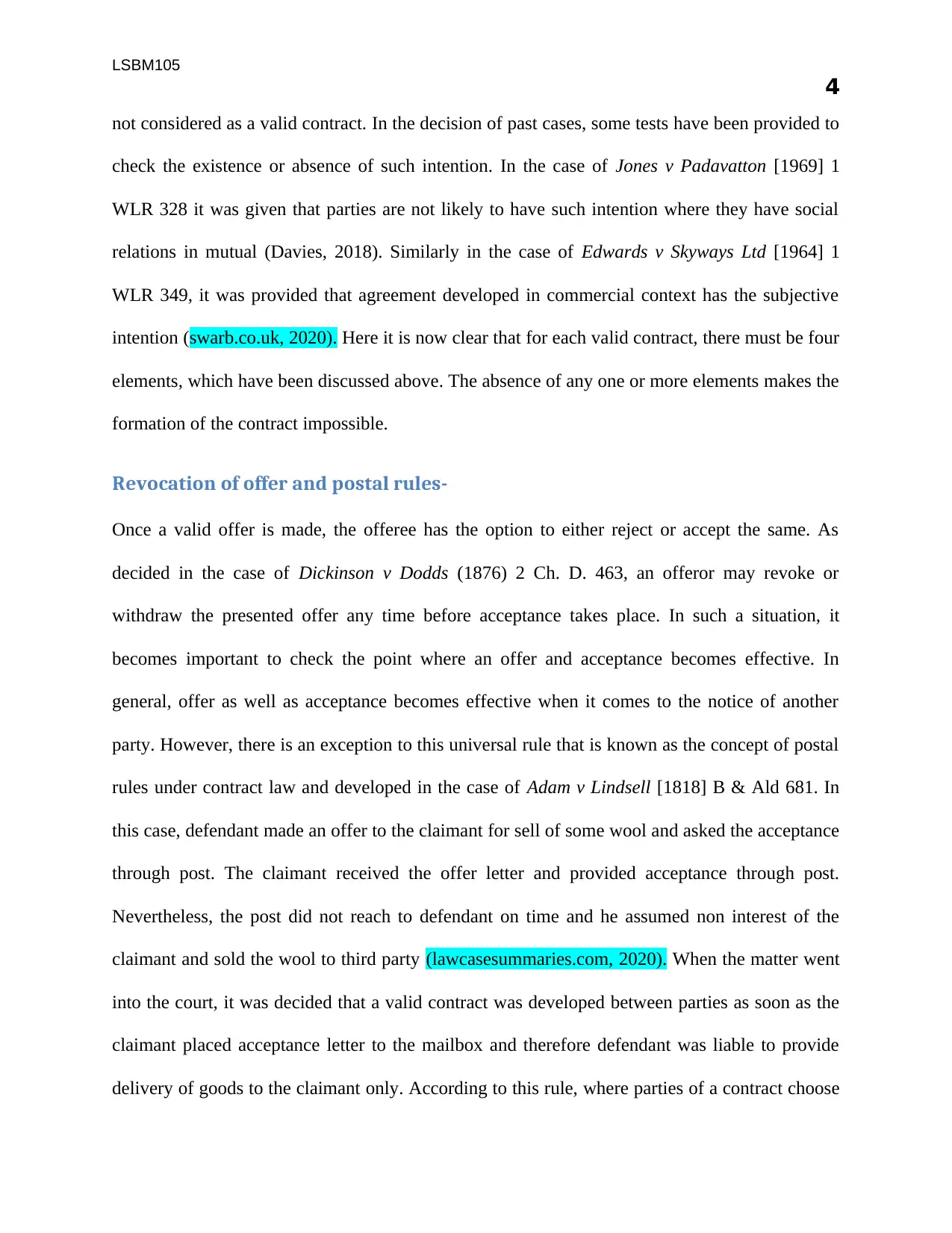
LSBM105
4
not considered as a valid contract. In the decision of past cases, some tests have been provided to
check the existence or absence of such intention. In the case of Jones v Padavatton [1969] 1
WLR 328 it was given that parties are not likely to have such intention where they have social
relations in mutual (Davies, 2018). Similarly in the case of Edwards v Skyways Ltd [1964] 1
WLR 349, it was provided that agreement developed in commercial context has the subjective
intention (swarb.co.uk, 2020). Here it is now clear that for each valid contract, there must be four
elements, which have been discussed above. The absence of any one or more elements makes the
formation of the contract impossible.
Revocation of offer and postal rules-
Once a valid offer is made, the offeree has the option to either reject or accept the same. As
decided in the case of Dickinson v Dodds (1876) 2 Ch. D. 463, an offeror may revoke or
withdraw the presented offer any time before acceptance takes place. In such a situation, it
becomes important to check the point where an offer and acceptance becomes effective. In
general, offer as well as acceptance becomes effective when it comes to the notice of another
party. However, there is an exception to this universal rule that is known as the concept of postal
rules under contract law and developed in the case of Adam v Lindsell [1818] B & Ald 681. In
this case, defendant made an offer to the claimant for sell of some wool and asked the acceptance
through post. The claimant received the offer letter and provided acceptance through post.
Nevertheless, the post did not reach to defendant on time and he assumed non interest of the
claimant and sold the wool to third party (lawcasesummaries.com, 2020). When the matter went
into the court, it was decided that a valid contract was developed between parties as soon as the
claimant placed acceptance letter to the mailbox and therefore defendant was liable to provide
delivery of goods to the claimant only. According to this rule, where parties of a contract choose
4
not considered as a valid contract. In the decision of past cases, some tests have been provided to
check the existence or absence of such intention. In the case of Jones v Padavatton [1969] 1
WLR 328 it was given that parties are not likely to have such intention where they have social
relations in mutual (Davies, 2018). Similarly in the case of Edwards v Skyways Ltd [1964] 1
WLR 349, it was provided that agreement developed in commercial context has the subjective
intention (swarb.co.uk, 2020). Here it is now clear that for each valid contract, there must be four
elements, which have been discussed above. The absence of any one or more elements makes the
formation of the contract impossible.
Revocation of offer and postal rules-
Once a valid offer is made, the offeree has the option to either reject or accept the same. As
decided in the case of Dickinson v Dodds (1876) 2 Ch. D. 463, an offeror may revoke or
withdraw the presented offer any time before acceptance takes place. In such a situation, it
becomes important to check the point where an offer and acceptance becomes effective. In
general, offer as well as acceptance becomes effective when it comes to the notice of another
party. However, there is an exception to this universal rule that is known as the concept of postal
rules under contract law and developed in the case of Adam v Lindsell [1818] B & Ald 681. In
this case, defendant made an offer to the claimant for sell of some wool and asked the acceptance
through post. The claimant received the offer letter and provided acceptance through post.
Nevertheless, the post did not reach to defendant on time and he assumed non interest of the
claimant and sold the wool to third party (lawcasesummaries.com, 2020). When the matter went
into the court, it was decided that a valid contract was developed between parties as soon as the
claimant placed acceptance letter to the mailbox and therefore defendant was liable to provide
delivery of goods to the claimant only. According to this rule, where parties of a contract choose
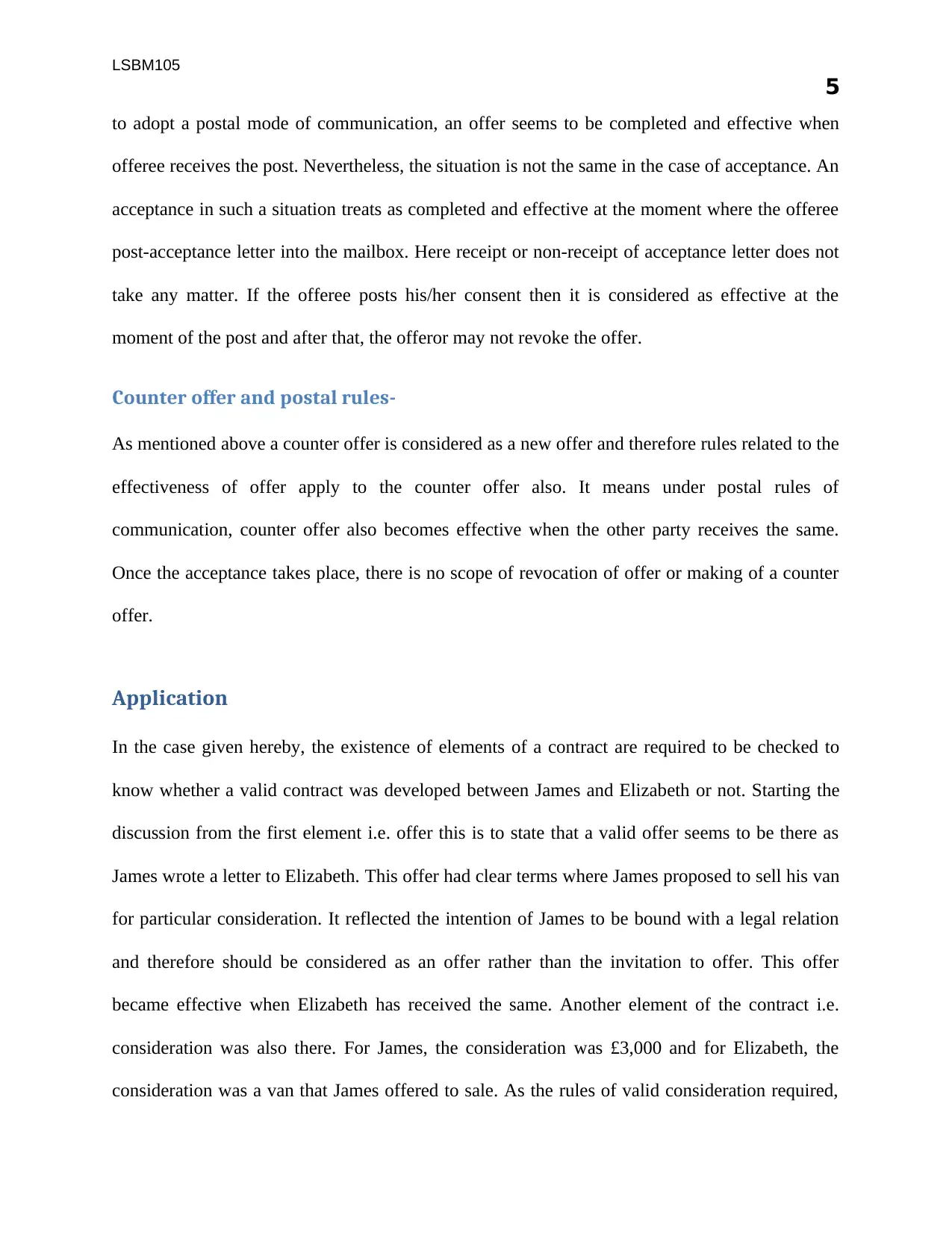
LSBM105
5
to adopt a postal mode of communication, an offer seems to be completed and effective when
offeree receives the post. Nevertheless, the situation is not the same in the case of acceptance. An
acceptance in such a situation treats as completed and effective at the moment where the offeree
post-acceptance letter into the mailbox. Here receipt or non-receipt of acceptance letter does not
take any matter. If the offeree posts his/her consent then it is considered as effective at the
moment of the post and after that, the offeror may not revoke the offer.
Counter offer and postal rules-
As mentioned above a counter offer is considered as a new offer and therefore rules related to the
effectiveness of offer apply to the counter offer also. It means under postal rules of
communication, counter offer also becomes effective when the other party receives the same.
Once the acceptance takes place, there is no scope of revocation of offer or making of a counter
offer.
Application
In the case given hereby, the existence of elements of a contract are required to be checked to
know whether a valid contract was developed between James and Elizabeth or not. Starting the
discussion from the first element i.e. offer this is to state that a valid offer seems to be there as
James wrote a letter to Elizabeth. This offer had clear terms where James proposed to sell his van
for particular consideration. It reflected the intention of James to be bound with a legal relation
and therefore should be considered as an offer rather than the invitation to offer. This offer
became effective when Elizabeth has received the same. Another element of the contract i.e.
consideration was also there. For James, the consideration was £3,000 and for Elizabeth, the
consideration was a van that James offered to sale. As the rules of valid consideration required,
5
to adopt a postal mode of communication, an offer seems to be completed and effective when
offeree receives the post. Nevertheless, the situation is not the same in the case of acceptance. An
acceptance in such a situation treats as completed and effective at the moment where the offeree
post-acceptance letter into the mailbox. Here receipt or non-receipt of acceptance letter does not
take any matter. If the offeree posts his/her consent then it is considered as effective at the
moment of the post and after that, the offeror may not revoke the offer.
Counter offer and postal rules-
As mentioned above a counter offer is considered as a new offer and therefore rules related to the
effectiveness of offer apply to the counter offer also. It means under postal rules of
communication, counter offer also becomes effective when the other party receives the same.
Once the acceptance takes place, there is no scope of revocation of offer or making of a counter
offer.
Application
In the case given hereby, the existence of elements of a contract are required to be checked to
know whether a valid contract was developed between James and Elizabeth or not. Starting the
discussion from the first element i.e. offer this is to state that a valid offer seems to be there as
James wrote a letter to Elizabeth. This offer had clear terms where James proposed to sell his van
for particular consideration. It reflected the intention of James to be bound with a legal relation
and therefore should be considered as an offer rather than the invitation to offer. This offer
became effective when Elizabeth has received the same. Another element of the contract i.e.
consideration was also there. For James, the consideration was £3,000 and for Elizabeth, the
consideration was a van that James offered to sale. As the rules of valid consideration required,
⊘ This is a preview!⊘
Do you want full access?
Subscribe today to unlock all pages.

Trusted by 1+ million students worldwide
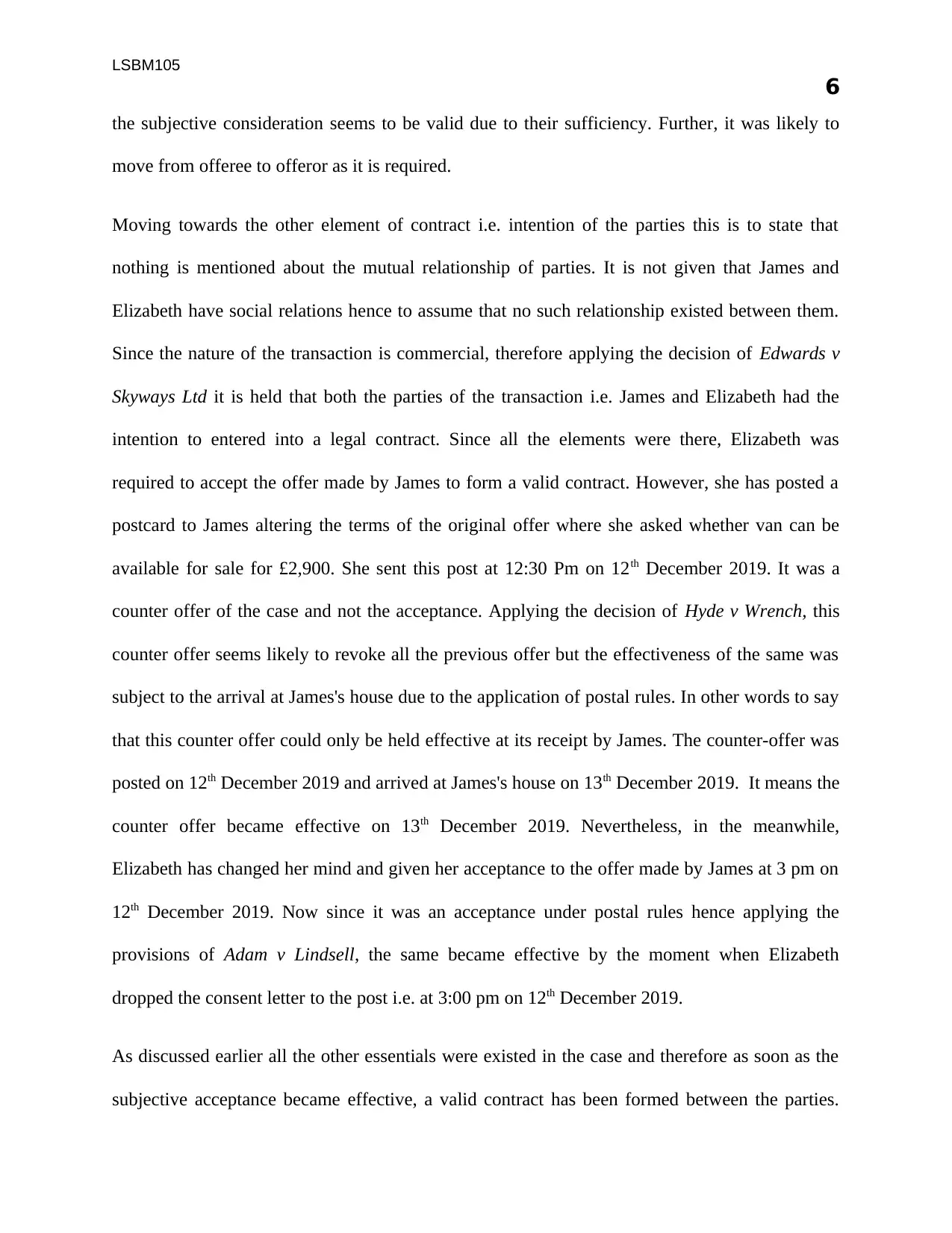
LSBM105
6
the subjective consideration seems to be valid due to their sufficiency. Further, it was likely to
move from offeree to offeror as it is required.
Moving towards the other element of contract i.e. intention of the parties this is to state that
nothing is mentioned about the mutual relationship of parties. It is not given that James and
Elizabeth have social relations hence to assume that no such relationship existed between them.
Since the nature of the transaction is commercial, therefore applying the decision of Edwards v
Skyways Ltd it is held that both the parties of the transaction i.e. James and Elizabeth had the
intention to entered into a legal contract. Since all the elements were there, Elizabeth was
required to accept the offer made by James to form a valid contract. However, she has posted a
postcard to James altering the terms of the original offer where she asked whether van can be
available for sale for £2,900. She sent this post at 12:30 Pm on 12th December 2019. It was a
counter offer of the case and not the acceptance. Applying the decision of Hyde v Wrench, this
counter offer seems likely to revoke all the previous offer but the effectiveness of the same was
subject to the arrival at James's house due to the application of postal rules. In other words to say
that this counter offer could only be held effective at its receipt by James. The counter-offer was
posted on 12th December 2019 and arrived at James's house on 13th December 2019. It means the
counter offer became effective on 13th December 2019. Nevertheless, in the meanwhile,
Elizabeth has changed her mind and given her acceptance to the offer made by James at 3 pm on
12th December 2019. Now since it was an acceptance under postal rules hence applying the
provisions of Adam v Lindsell, the same became effective by the moment when Elizabeth
dropped the consent letter to the post i.e. at 3:00 pm on 12th December 2019.
As discussed earlier all the other essentials were existed in the case and therefore as soon as the
subjective acceptance became effective, a valid contract has been formed between the parties.
6
the subjective consideration seems to be valid due to their sufficiency. Further, it was likely to
move from offeree to offeror as it is required.
Moving towards the other element of contract i.e. intention of the parties this is to state that
nothing is mentioned about the mutual relationship of parties. It is not given that James and
Elizabeth have social relations hence to assume that no such relationship existed between them.
Since the nature of the transaction is commercial, therefore applying the decision of Edwards v
Skyways Ltd it is held that both the parties of the transaction i.e. James and Elizabeth had the
intention to entered into a legal contract. Since all the elements were there, Elizabeth was
required to accept the offer made by James to form a valid contract. However, she has posted a
postcard to James altering the terms of the original offer where she asked whether van can be
available for sale for £2,900. She sent this post at 12:30 Pm on 12th December 2019. It was a
counter offer of the case and not the acceptance. Applying the decision of Hyde v Wrench, this
counter offer seems likely to revoke all the previous offer but the effectiveness of the same was
subject to the arrival at James's house due to the application of postal rules. In other words to say
that this counter offer could only be held effective at its receipt by James. The counter-offer was
posted on 12th December 2019 and arrived at James's house on 13th December 2019. It means the
counter offer became effective on 13th December 2019. Nevertheless, in the meanwhile,
Elizabeth has changed her mind and given her acceptance to the offer made by James at 3 pm on
12th December 2019. Now since it was an acceptance under postal rules hence applying the
provisions of Adam v Lindsell, the same became effective by the moment when Elizabeth
dropped the consent letter to the post i.e. at 3:00 pm on 12th December 2019.
As discussed earlier all the other essentials were existed in the case and therefore as soon as the
subjective acceptance became effective, a valid contract has been formed between the parties.
Paraphrase This Document
Need a fresh take? Get an instant paraphrase of this document with our AI Paraphraser
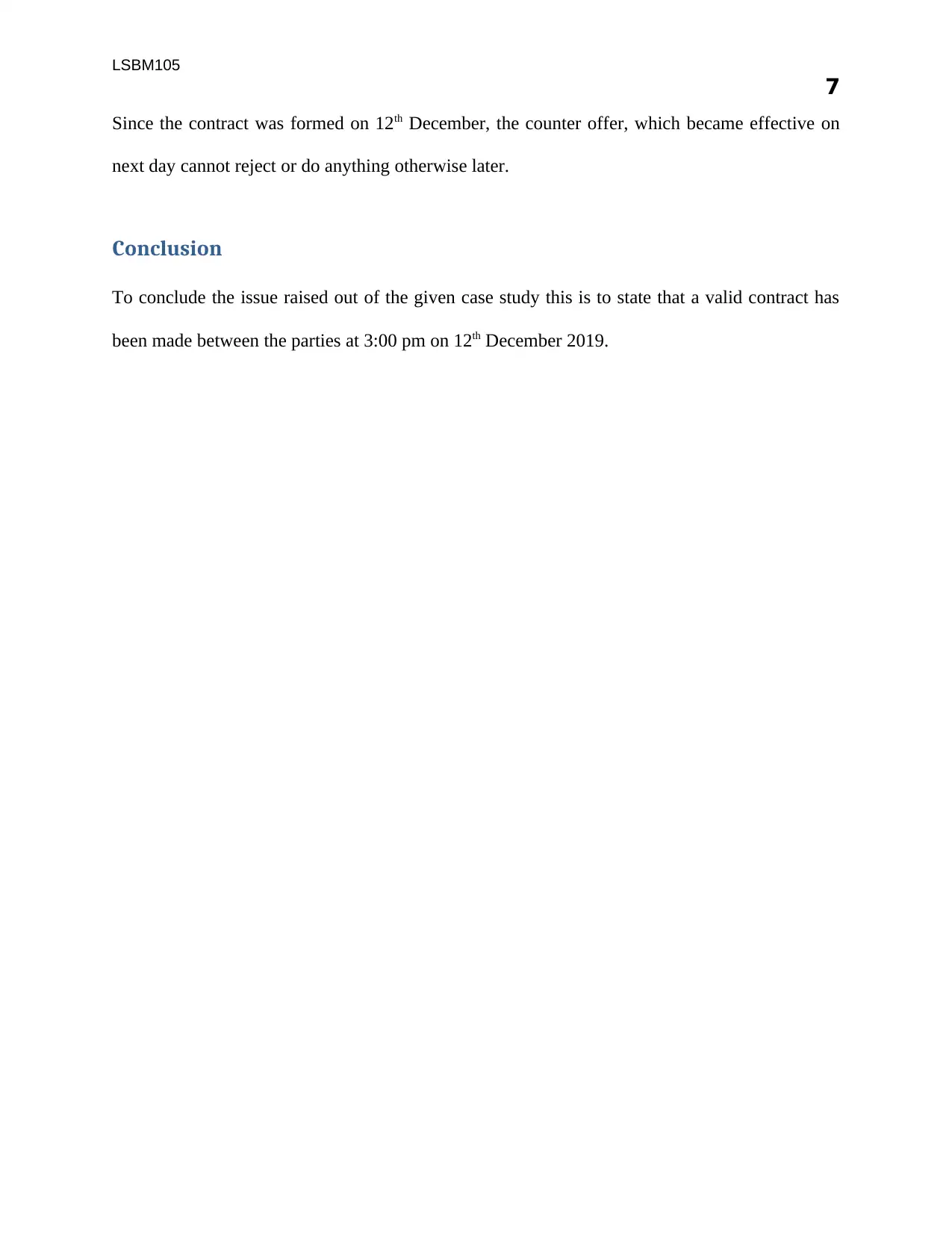
LSBM105
7
Since the contract was formed on 12th December, the counter offer, which became effective on
next day cannot reject or do anything otherwise later.
Conclusion
To conclude the issue raised out of the given case study this is to state that a valid contract has
been made between the parties at 3:00 pm on 12th December 2019.
7
Since the contract was formed on 12th December, the counter offer, which became effective on
next day cannot reject or do anything otherwise later.
Conclusion
To conclude the issue raised out of the given case study this is to state that a valid contract has
been made between the parties at 3:00 pm on 12th December 2019.
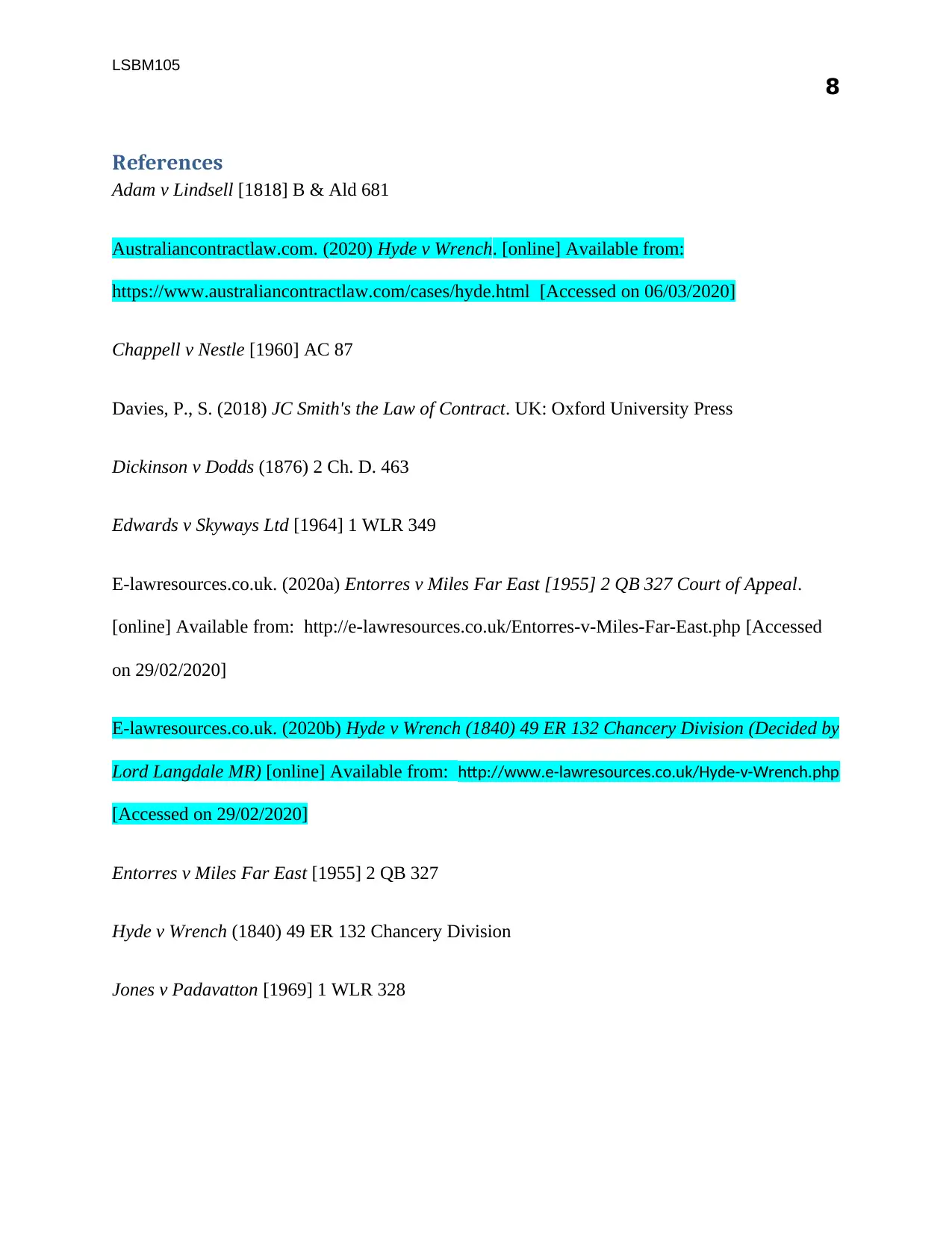
LSBM105
8
References
Adam v Lindsell [1818] B & Ald 681
Australiancontractlaw.com. (2020) Hyde v Wrench. [online] Available from:
https://www.australiancontractlaw.com/cases/hyde.html [Accessed on 06/03/2020]
Chappell v Nestle [1960] AC 87
Davies, P., S. (2018) JC Smith's the Law of Contract. UK: Oxford University Press
Dickinson v Dodds (1876) 2 Ch. D. 463
Edwards v Skyways Ltd [1964] 1 WLR 349
E-lawresources.co.uk. (2020a) Entorres v Miles Far East [1955] 2 QB 327 Court of Appeal.
[online] Available from: http://e-lawresources.co.uk/Entorres-v-Miles-Far-East.php [Accessed
on 29/02/2020]
E-lawresources.co.uk. (2020b) Hyde v Wrench (1840) 49 ER 132 Chancery Division (Decided by
Lord Langdale MR) [online] Available from: http://www.e-lawresources.co.uk/Hyde-v-Wrench.php
[Accessed on 29/02/2020]
Entorres v Miles Far East [1955] 2 QB 327
Hyde v Wrench (1840) 49 ER 132 Chancery Division
Jones v Padavatton [1969] 1 WLR 328
8
References
Adam v Lindsell [1818] B & Ald 681
Australiancontractlaw.com. (2020) Hyde v Wrench. [online] Available from:
https://www.australiancontractlaw.com/cases/hyde.html [Accessed on 06/03/2020]
Chappell v Nestle [1960] AC 87
Davies, P., S. (2018) JC Smith's the Law of Contract. UK: Oxford University Press
Dickinson v Dodds (1876) 2 Ch. D. 463
Edwards v Skyways Ltd [1964] 1 WLR 349
E-lawresources.co.uk. (2020a) Entorres v Miles Far East [1955] 2 QB 327 Court of Appeal.
[online] Available from: http://e-lawresources.co.uk/Entorres-v-Miles-Far-East.php [Accessed
on 29/02/2020]
E-lawresources.co.uk. (2020b) Hyde v Wrench (1840) 49 ER 132 Chancery Division (Decided by
Lord Langdale MR) [online] Available from: http://www.e-lawresources.co.uk/Hyde-v-Wrench.php
[Accessed on 29/02/2020]
Entorres v Miles Far East [1955] 2 QB 327
Hyde v Wrench (1840) 49 ER 132 Chancery Division
Jones v Padavatton [1969] 1 WLR 328
⊘ This is a preview!⊘
Do you want full access?
Subscribe today to unlock all pages.

Trusted by 1+ million students worldwide

LSBM105
9
lawcasesummaries.com. (2020) Adams v Lindsell [1818] EWHC KB J59. [online] Available
from: https://lawcasesummaries.com/knowledge-base/adams-v-lindsell-1818-ewhc-kb-j59/
[Accessed on 06/03/2020]
webstroke.co.uk. (2020) Chappel v Nestle [1960]. [online] Available from:
https://webstroke.co.uk/law/cases/chappel-v-nestle-1960 [Accessed on 06/03/2020]
swarb.co.uk. (2020) Edwards V Skyways Ltd: Qbd 1964. [online] Available from:
https://swarb.co.uk/edwards-v-skyways-ltd-qbd-1964/ [Accessed on 06/03/2020]
9
lawcasesummaries.com. (2020) Adams v Lindsell [1818] EWHC KB J59. [online] Available
from: https://lawcasesummaries.com/knowledge-base/adams-v-lindsell-1818-ewhc-kb-j59/
[Accessed on 06/03/2020]
webstroke.co.uk. (2020) Chappel v Nestle [1960]. [online] Available from:
https://webstroke.co.uk/law/cases/chappel-v-nestle-1960 [Accessed on 06/03/2020]
swarb.co.uk. (2020) Edwards V Skyways Ltd: Qbd 1964. [online] Available from:
https://swarb.co.uk/edwards-v-skyways-ltd-qbd-1964/ [Accessed on 06/03/2020]
1 out of 10
Related Documents
Your All-in-One AI-Powered Toolkit for Academic Success.
+13062052269
info@desklib.com
Available 24*7 on WhatsApp / Email
![[object Object]](/_next/static/media/star-bottom.7253800d.svg)
Unlock your academic potential
Copyright © 2020–2025 A2Z Services. All Rights Reserved. Developed and managed by ZUCOL.




